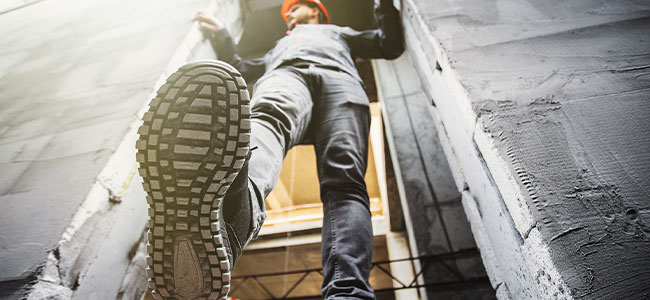
Put Your Best Footwear Forward
Stepping up safety for specific environmental, application and exposure risks.
- By Nick Larkins
- Mar 01, 2024
For centuries, workers have sought out the right tool for the job, carrying a tool bag full of different wrenches, screwdrivers, and plyers, yet some still wear the same pair of work boots for every type of environment, application, and exposure. It’s time to empower America’s workforce to get the job done safely by stepping up to offer the right boots for the job to be done every time.
Through my company’s partnership with the Elite Trades Championship Series, we have engaged with the best auto-tech, electrical, HVAC and plumbing tradespeople in the country. We have seen firsthand the varied conditions that America’s tradespeople face throughout their day.
A quick survey of tradespeople with varied working conditions revealed that they carry an average of three pairs of work boots for the various tasks they perform regularly. Just like each bolt has its corresponding wrench, and each job has its corresponding tools, using fit-for-purpose protective footwear ensures proper foot protection for the job at hand. Do your workers have access to the full assortment of protective footwear options needed for the work they perform?
Matching Footwear to the Task at Hand
When the type of work performed or the job site conditions vary, typical leather work boots alone may not be enough to handle the task at hand. Having the right tool for the job is key to maximizing efficiency and effectiveness on the job: For the HVAC workers pouring concrete slabs for compressors; for the plumbing professionals working on emergency leaks; or for electrical workers installing a new electrical panel in less-than-ideal weather conditions that leather work boots are not equipped to handle. Not to worry, PPE manufacturers have fit-for-purpose solutions to keep you safe, comfortable and dry until the job is done.
What is foot protection? Foot protection can generally be defined as any piece of personal protective equipment protecting one’s foot from injury while at work or during movement. Protective footwear is designed to mitigate risks from rolling objects, falling objects, kicking, crushing hazards, objects piercing the sole, as well as exposures to electrical, chemical or flash fire hazards.
Proper protective footwear is the most important factor in reducing the potential for foot-related accidents and injury that may result from environmental, application, or exposure risks and acts as the critical control point for these hazards when they cannot be effectively reduced or eliminated with equipment or processes. Remember, in many organizations, 100 percent of the workforce will be on their feet at some point during their working day, making foot protection a high exposure risk for most, if not all, of your workers.
Exposure to Hazards
The need for protective footwear is often misjudged in terms of exposure levels and risks to workers. Similarly, the impact that proper footwear can have in mitigating those risks is often underestimated. Common exposures that are often overlooked include water or wet flooring, cleaning agents and floor waxes with or without other debris present. In wet environments, 100 percent waterproof protective footwear is the best mitigation.
The identification of exposure hazards and the application of protective footwear that has the necessary features to mitigate against those hazards should be included in your safety plan and PPE requirements for affected workers. Training, maintenance, and storage should all be considered key elements of making protective footwear part of the team’s daily work. Information and instruction should be provided to workers to ensure foot protection PPE is adopted, properly worn, maintained, and replaced as necessary.
The ASTM F2413-18 standard contains the certification requirements for safety features that mitigate against injury to the foot. Depending on your specific circumstances, you may need one or more safety features to protect your workers. Look for these features and certifications:
• Protective Toecap — (I/C) protects against impact and compression in the toe area
• Protective Midsole — (PR) protects against puncture from below
• Metatarsal Protection — (MT) protects against impacts to the top of foot
• Electrical Hazard Protection — (EH) protects from electrocution
• Static Dissipative — (SD) protects from excess static build-up and discharge
While protecting the foot from injury is job one for foot protection PPE, selecting the proper footwear for your environment, application and exposure needs that is also certified to meet or exceed slip resistance standards can significantly reduce rates of slip, trip and fall accidents. OSHA estimates nearly one in three non-fatal workplace accidents are slip-, trip- or fall-related. When selecting, look for footwear that is ASTM F3445-21 SR certified, the latest ASTM slip resistance standard.
Other protection, such as chemical resistance and flash fire resistance, should also be considered if relevant based on your most recent site hazard assessment. Protective footwear may include additional features such as tread wear indicators. The wear tread indicator is a simple, visual way to identify product end of life when slip resistance is no longer optimal and replacement is warranted. When your workforce’s PPE usage varies widely, or working conditions are particularly harsh, time may not be the best predictor of your protective footwear’s useful wear life; wear tread indicators are particularly useful in these cases.
Understanding the purpose of protective footwear and the environment, application and potential exposures of workers are key first steps in developing a fit-for-purpose footwear program.
This article originally appeared in the February/March 2024 issue of Occupational Health & Safety.